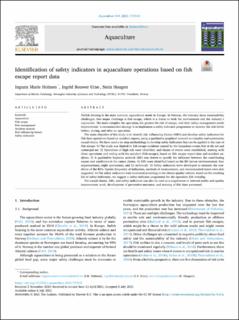| dc.contributor.author | Holmen, Ingunn Marie | |
| dc.contributor.author | Utne, Ingrid Bouwer | |
| dc.contributor.author | Haugen, Stein | |
| dc.date.accessioned | 2022-02-23T09:30:41Z | |
| dc.date.available | 2022-02-23T09:30:41Z | |
| dc.date.created | 2021-11-22T18:43:40Z | |
| dc.date.issued | 2021 | |
| dc.identifier.citation | Aquaculture. 2021, 544, . | en_US |
| dc.identifier.issn | 0044-8486 | |
| dc.identifier.uri | https://hdl.handle.net/11250/2980926 | |
| dc.description.abstract | Finfish farming is the most common aquaculture mode in Europe. In Norway, the industry faces sustainability challenges. One major challenge is fish escape, which is a threat to both the environment and the industry's reputation. The more complex the operation, the greater the risk of escape, and their safety management needs improvement. A recommended strategy is to implement a safety indicator programme to monitor the risk levels before, during, and after an operation.
The main objective of this study is to identify risk influencing factors (RIFs) and develop safety indicators for fish farm operations based on accident reports, using a qualitative graphical network to visualise and systematise causal chains. We have used a six-step methodology to develop safety indicators that can be applied to the case of fish escape: 1) The study was limited to fish escape accidents caused by the hazardous events hole in the net and submerged net. 2) Operations of high risk were identified, and chains of events were established, starting with these operations and ending with the accident (fish escape), based on fish escape report data and accident analyses. 3) A qualitative Bayesian network (BN) was drawn to specify the influence between the contributing causes and conditions in the causal chains. 4) RIFs were identified based on the BN (seven environmental, four organisational, eight operational, and 12 technical). 5) Safety indicators were developed to measure the condition of the RIFs. Update frequency of indicators, methods of measurement, and recommended states were also suggested. 6) The safety indicators were evaluated according to the chosen quality criteria. Based on the resulting list of safety indicators, we suggest a safety indicator programme for the operation fish crowding.
The causal chains, RIFs, and safety indicators can also be used as a supplement in internal audits and quality improvement work, development of preventive measures, and training of fish farm personnel. | en_US |
| dc.language.iso | eng | en_US |
| dc.publisher | Elsevier Ltd. | en_US |
| dc.relation.uri | https://doi.org/10.1016/j.aquaculture.2021.737143 | |
| dc.rights | Navngivelse 4.0 Internasjonal | * |
| dc.rights.uri | http://creativecommons.org/licenses/by/4.0/deed.no | * |
| dc.subject | Risikostyring | en_US |
| dc.subject | Risk management | en_US |
| dc.subject | Helse, miljø og sikkerhet | en_US |
| dc.subject | Safety,health and environment | en_US |
| dc.subject | Fiskeoppdrett | en_US |
| dc.subject | Fish farming | en_US |
| dc.title | Identification of safety indicators in aquaculture operations based on fish escape report data. | en_US |
| dc.type | Peer reviewed | en_US |
| dc.type | Journal article | en_US |
| dc.description.version | publishedVersion | en_US |
| dc.subject.nsi | VDP::Marin teknologi: 580 | en_US |
| dc.subject.nsi | VDP::Marine technology: 580 | en_US |
| dc.source.pagenumber | 17 | en_US |
| dc.source.volume | 544 | en_US |
| dc.source.journal | Aquaculture | en_US |
| dc.identifier.doi | 10.1016/j.aquaculture.2021.737143 | |
| dc.identifier.cristin | 1957450 | |
| dc.relation.project | Norges forskningsråd: 237790 | en_US |
| dc.source.articlenumber | 737143 | en_US |
| cristin.ispublished | true | |
| cristin.fulltext | original | |
| cristin.qualitycode | 2 | |

